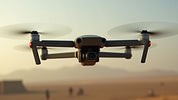
Cheap Drones Reshape Modern Warfare: Asymmetrical Combat Redefines Global Military Strategy
, by Unboxify, 4 min reading time

, by Unboxify, 4 min reading time
The recent aerial assault on Israel by Iranian drones has underscored a new reality in modern warfare: the era of cost-effective drone combat. This shift isn't isolated; it spans from Iran to Ukraine, redefining the strategies utilized on today's battlefields.
Ukraine, too, is enduring relentless aerial assaults, primarily from Russian drones. These drones are often sourced or inspired by models developed in Iran, a country that's found a way to circumvent international sanctions to advance its drone technology. Even the Kremlin has experienced substantial drone attacks, demonstrating that no nation is immune to this technological paradigm shift.
The Israeli bombardment of a building near the Iranian embassy in Damascus on April 1st, which resulted in the death of several senior Iranian generals, catalyzed Iran's move to deploy drones. In retaliation, Iran launched a swarm of drones designed to overwhelm Israeli defenses, followed by a barrage of missiles aimed to exploit any gaps in those defenses.
The utility of drones in modern warfare can be compared to the introduction of the AK-47 in 21st-century combat. Their relatively low cost and ease of production make them invaluable assets for less technologically advanced nations aiming to level the playing field.
Historically, warfare advancements have been made by the most technologically superior powers, further widening the gap between them and less advanced nations. Drone warfare, however, has enabled these weaker powers to bridge that capability gap.
The primary Iranian drone manufacturer, Shahed Aviation Industries, is a subsidiary of the Revolutionary Guards. They creatively navigate around international sanctions using numerous small companies and global smuggling networks to procure necessary components.
Shahed drones are deployed in conflict zones like Syria, Russia, Ethiopia, Tajikistan, and Venezuela. The Shahed-136 model, for instance, can carry up to 50 kilograms of explosives and has a range of up to 2500 kilometers, making it possible for Iran to strike targets deep within Israel's territory without relying on proxy forces.
The cost dynamics of drone warfare are eye-opening. While Israel spends millions defending against these drones, the drones themselves cost a mere fraction of that amount. For instance:
Iran's ability to use these cost-effective drones exerts a financial strain on Israel, forcing it to continue replenishing its air defenses at great expense. Without these drones, Iran would need to deploy jet fighters, which would be a riskier and more costly proposition.
Iran's Yemen-based proxy, the Houthis, have already demonstrated the disruptive potential of inexpensive drones by threatening trade routes in the Red Sea. These low-cost yet accurate missiles and drones are enough to significantly alter maritime security dynamics.
In Ukraine, cheap consumer drones, largely from Chinese manufacturers, have been adapted to drop explosives on high-value targets like multimillion-dollar tanks. This has been particularly effective against the Russian navy, enabling Ukraine to inflict considerable damage on Russia's naval fleet in the Black Sea.
As nations like the United States and Israel grapple with the rising tide of cost-effective drones, there's an urgent need to reassess military expenditure. Traditionally, defense budgets have favored sophisticated, expensive weapon systems. However, the burgeoning threat of cheap drone warfare necessitates a shift in focus.
Both the U.S. and Germany are developing counter-drone technologies, including:
The challenge lies in creating affordable defensive systems that can counter the threat posed by inexpensive, yet deadly, drones.
The defense industry, traditionally inclined toward multi-billion-dollar investments in high-tech platforms, must align their strategies with the realities of modern warfare. Governments must incentivize the development and deployment of affordable, networked drone technology to keep pace with evolving threats.
Ultimately, the rise of cheap drone warfare underscores the need for nations to innovate continuously and adapt to new modes of conflict. The future of warfare may well be decided not by who spends the most, but by who can deploy the most cost-effective and efficient technologies.






